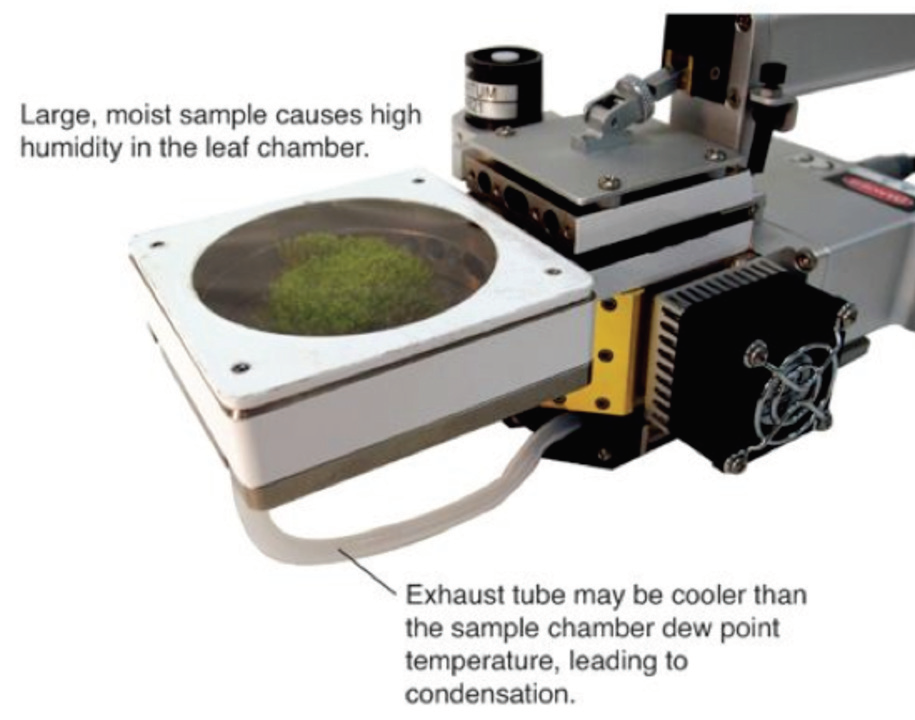Printable PDF: Dealing with Large, Moist Samples With the LI-6400XT Portable Photosynthesis System
Instructions for dealing with large, moist samples.
With large chambers such as the 6400-24 Bryophyte Chamber, the 6400-05 and 6400-22 Conifer Chambers, or a large custom chamber, it is possible to measure large samples. An advantage of large samples is that larger CO2 differentials are possible, even at lower photosynthesis rates, leading to higher precision in the photosynthesis measurement. With large moist samples in the chamber however, not only is delta CO2 larger, but chamber humidity will also be higher. Typically, we recommend maintaining chamber relative humidity between 50% to 80%.
Maintaining adequate humidity is especially important for some types of samples such as mosses and lichens which may become stressed during the measurement. However, with large moist samples, it may not be possible to keep humidity below condensing conditions. Even using the maximum available flow rates (typically ~700 μmol/s) and with all of the air flow diverted through the desiccant, chamber humidity may approach saturation. Under these conditions, it is likely that condensation will form in the chamber exhaust tube (see Figure 1‑1). This will occur especially if the chamber temperature is warmer than the ambient temperature, which is likely because the chamber is usually illuminated by a light source and is also thermally connected to the rest of the sensor head. Under these conditions, Matching will introduce errors, because the air will change its water vapor concentration as it transits through the cooler exit tube that leads to the reference gas analyzer (IRGA). When the chamber air temperature control via the thermo-electric coolers is not active, the chamber air temperature is typically several degrees C warmer than the ambient air temperature.
To check for this potential problem, use the 6400-04 Leaf Temperature Thermocouple to measure the temperature outside of the sensor head, and compare this to the sample chamber Dew Point Temperature, Td_S (on display line F in the Default screen of the LI-6400). If Td_S is higher than ambient temperature, then condensation will likely occur in the sample chamber exit tube. After Matching the analyzers with condensation present in the exhaust tube, an error will be introduced into the Sample IRGA water vapor reading. This will lead to errors in computing the water vapor dilution corrections when calculating photosynthetic rates (see the LI-6400XT manual, Chapter 1, for plant gas exchange equations). It should be noted that with wet samples (with free liquid water), stomatal conductance and Ci calculations become meaningless, and only photosynthetic rates are relevant.
In one example using the 6400-24 Bryophyte chamber with no light source, the sample chamber air temperature, Tair, had a stable working value of ~30 °C (saturation vapor pressure, es(30) = 4.26 kPa = 43.47 mmol/mol) after 1 hour of use, while the ambient room temperature was only ~25 °C (es(25)= 3.18 kPa = 32.45 mmol/mol). If the instrument was matched under these conditions, with nearly saturated air leaving the sample chamber and was cooled to room temperature in the exit tube, an error of about -10 mmol/mol would be made in the sample chamber water vapor mole fraction. At a sample chamber CO2 concentration of 400 μmol/mol-1, this would represent a CO2 dilution error of approximately -4 μmol/mol-1. In actual tests with a 15 cm2 piece of wet filter paper, errors in the sample chamber water vapor mole fraction were of the order of -2 to -4 mmol/mol representing sample IRGA CO2 errors of about -1 to -2 ppm. The air leaving the sample chamber was not fully saturated, and the interior wall of the exit tube was probably warmer than room temperature. Even so, these are serious errors, especially at low photosynthesis rates, and are generated by matching under these conditions.

One possible approach to prevent this problem is to lower the chamber temperature below ambient using the LI-6400XT thermoelectric coolers. However, when measuring large, moist samples in the chamber, cooling the block and chamber temperature increases the risk of condensing water vapor on the chamber walls and inside the gas analyzer, which will interfere with the optics. The LI-6400XT warns of this risk (with a “High Humidity” alert) if the temperatures are within a degree C of the dew point. The effectiveness of this approach will depend on how much cooling of the block temperature is required to avoid condensation in the leaf chamber exhaust tube.
A more robust way to prevent errors due to matching with large, moist samples is to change the Matching method to Fan-based (see LI-6400XT manual, Chapter 16 for details). Fan-based matching causes the system to briefly turn off the leaf chamber mixing fan rather than actuating the match valve. While the mixing fan is off, the leaf chamber volume becomes isolated from the sample IRGA cell, and both the Sample and the Reference IRGA cell volumes are flushed with the same conditioned air coming from the console. With fan-based matching, the incoming (Reference) gas concentration is used to match the analyzers, rather than using the sample chamber concentrations. With fan-based matching, it may be preferable to set the desiccant knob to full bypass; this way, the reference vapor pressure will be closer to the sample chamber vapor pressure, and there will be a shortened transition prior to Matching. Fan-based matching is useful for measuring any large samples where condensation in the exit tube, or lengthy gas concentration equilibration times are an issue.
